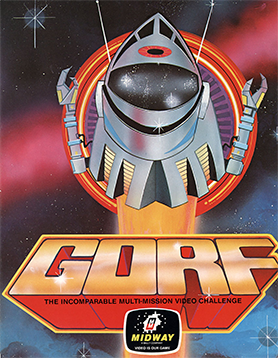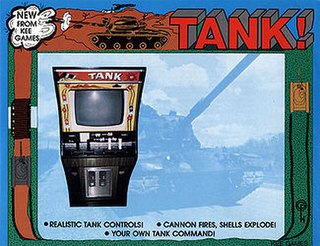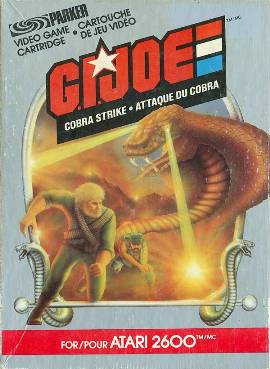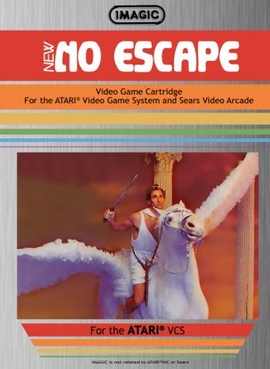
The Atari 2600 is a home video game console developed and produced by Atari, Inc. Released in September 1977, it popularized microprocessor-based hardware and games stored on swappable ROM cartridges, a format first used with the Fairchild Channel F in 1976. Branded as the Atari Video Computer System from its release until November 1982, the VCS was bundled with two joystick controllers, a conjoined pair of paddle controllers, and a game cartridge—initially Combat and later Pac-Man.

Berzerk is a multidirectional shooter designed by Alan McNeil and released for arcades in 1980 by Stern Electronics of Chicago. Following Taito's Stratovox, it is one of the first arcade video games with speech synthesis. Berzerk places the player in a series of top-down, maze-like rooms containing armed robots. Home ports were published for the Atari 2600, Atari 5200, and Vectrex.

Mouse Trap is a maze video game developed by Exidy and released in arcades in 1981. It is similar to Pac-Man, with the main character replaced by a mouse, the dots with cheese, the ghosts with cats, and the energizers with bones. After collecting a bone, pressing a button turns the mouse into a dog for a brief period of time. Color-coded doors in the maze can be toggled by pressing a button of the same color. A hawk periodically flies across the maze, unrestricted by its walls.

Dig Dug is a maze arcade video game developed by Namco in 1981 and released in 1982, distributed in North America by Atari, Inc. The player controls Dig Dug to defeat all enemies per stage, by either inflating them to bursting or crushing them underneath rocks.

Gorf is an arcade video game released in 1981 by Midway Manufacturing, whose name was advertised as an acronym for "Galactic Orbiting Robot Force". It is a fixed shooter with five distinct levels, the first of which is based on Space Invaders and another on Galaxian. The game makes heavy use of synthesized speech for the Gorfian robot which teases the player, powered by the Votrax speech chip. Gorf allows the player to buy two additional lives per quarter before starting the game, for a maximum of seven lives.

Combat is a 1977 video game by Atari, Inc. for the Atari Video Computer System. In the game, two players controlling either a tank, a biplane, or a jet fire missiles at each other for two minutes and sixteen seconds. Points are scored by hitting the opponent, and the player with the most points when the time runs out wins. Variations on the gameplay introduce elements such as invisible vehicles, missiles that ricochet off of walls, and different playing fields.

The TV Boy, and its successors TV Boy II and Super TV Boy, are handheld TV games sold by many different companies, including Systema, Akor, and NICS, based upon an unlicensed clone of Atari 2600 hardware. They were released around 1992 and three years later, an improved version of the TV Boy 2, the Super TV Boy, was also made by Akor. They were widely available across Europe. In the UK, they were most visibly available through Argos.

Communist Mutants from Space is a fixed shooter video game programmed by Stephen H. Landrum for the Atari 2600 with the Starpath Supercharger cassette accessory. It was published in 1982 by Starpath. The game is similar to Galaxian, adding a variety of gameplay-changing options.

Alien is a 1982 maze video game for the Atari 2600 published by 20th Century Fox. It is a maze game, based on the 1979 Alien film, and was written by Doug Neubauer who is credited in the packaging as "Dallas North." Neubauer is best known for 1979's Star Raiders. Alien for the Atari 2600 is the first officially licensed game of the Alien film series.

Tank is an arcade game developed by Kee Games, a subsidiary of Atari, and released in November 1974. It was one of the few original titles not based on an existing Atari property developed by Kee Games, which was founded to sell clones of Atari games to distributors as a fake competitor prior to the merger of the two companies. In the game, two players drive tanks through a maze viewed from above while attempting to shoot each other and avoid mines, represented by X marks, in a central minefield. Each player controls their tank with a pair of joysticks, moving them forwards and back to drive, reverse, and steer, and firing shells with a button to attempt to destroy the other tank. The destruction of a tank from a mine or shell earns the opposing player a point, and tanks reappear after being destroyed. The winner is the player with more points when time runs out, with each game typically one or two minutes long.

G.I. Joe: Cobra Strike is a video game written by John Emerson for the Atari 2600 in 1983. The game was developed and published by Parker Brothers and involves three different types of gameplay. The game is loosely based on the G.I. Joe franchise of the same name and is the first licensed G.I. Joe video game. The UK version was renamed Action Man: Action Force.

Pac-Man is a 1982 maze video game developed and published by Atari, Inc. under official license by Namco, and an adaptation of the 1980 hit arcade game of the same name. The player controls the title character, who attempts to consume all of the wafers while avoiding four ghosts that pursue him. Eating flashing wafers at the corners of the screen will cause the ghosts to turn temporarily blue and flee, allowing Pac-Man to eat them for bonus points.

Skeet Shoot is a skeet shooting video game for the Atari 2600 and the first game released by Games by Apollo in December 1981. Players assume the role of a skeet shooter shooting clay pigeons. There is a two-player mode where the players alternate.
In video games, first person is any graphical perspective rendered from the viewpoint of the player's character, or a viewpoint from the cockpit or front seat of a vehicle driven by the character. The most popular type of first-person video game today is the first-person shooter (FPS), in which the graphical perspective is an integral component of the gameplay. Many other genres incorporate first-person perspectives, including other types of shooter games, adventure games, amateur flight simulations, racing games, role-playing video games, and vehicle simulations.

Assault is a 1983 fixed shooter video game developed and published by Bomb for the Atari 2600. Controlling a spaceship fixated at the bottom of the screen, gameplay involves the player shooting projectiles towards an enemy mothership that deploys smaller ships to attack the player. The player must also prevent enough projectiles from touching the bottom of the screen.

Lost Luggage is a 1982 action video game developed and published by Games by Apollo for the Atari 2600. The player controls skycaps working at an airport and tries to collect pieces of luggage that fall overhead from a frantic luggage carousel. A two-player mode, in which the second player controls the direction the luggage falls, is also available.
CommaVid Inc. was a game developer and publisher for the Atari 2600 that released six games between 1981 and 1983, plus a programming tool for the console. The company was founded by Dr. Irwin Gaines, Dr. John Bronstein, and Dr. Joseph Biel under the name Computer Magic Video, which was shortened to Com Ma Vid, or CommaVid. It was based in Aurora, Illinois. In addition to developing its own titles, CommaVid ported the arcade game Venture to the 2600 for Coleco.

Fire Fighter is a video game written by Brad Stewart for the Atari 2600 published by Imagic in 1982. The player uses fire fighting equipment in an attempt to extinguish the fire in a tall building and rescue the occupants.

No Escape! is an Atari 2600 video game developed and published by Imagic in 1983. The player controls Jason, leader of the Argonauts, who fights off the Furies sent by the Greek gods. A two-player mode, in which the second player competes against the first turn-by-turn, is also available.

















